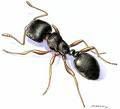Monday, September 19, 2005
Carpenter Ants Fact and Treatment Lists
From these resources, I've put together a summarized listing of the important facts about carpenter ants:
- Carpenter ants do not eat wood like termites, but tunnel into wood to make a nest
- Carpenter ants don't cause as much damage as termites
- Typical carpenter ants are one-quarter to one-half inch long and blackish
- Carpenter ants are attracted to moist wood
- Swarms of winged carpenter ants often emerge inside in the spring
- Swarms of winged carpenter ants are signs that there is a nest in the house
- One sign that carpenter ants are present is a sawdust-like pile outside an opening
- The ants' sawdust-like piles often have insect parts mixed among them
- Damage depends on how many active nests are inside the house
This understanding of the carpenter ants can help you formulate the best carpenter ant treatment and prevention. Here's a listing of some basic prevention and treatment methods:
- Sources of excess moisture inside your home need to be fixed
- Remove tree limbs that are touching the house
- Any other cracks around the house are possible entry points and should be sealed
- The best way to control carpenter ants is to find and destroy the nests
- Find nests by using baits and letting the ants lead you to the nests
- Home made baits can be made with maple syrup or honey on non-sticky side of tape
- One treatment is to drill small holes in the wood and inject an insecticide
- Boric Acid dust is an effective ant insecticide
- Maxforce Carpenter Ant Bait Gel is often used by professionals
- The Gel bait can be injected into cracks with syringes which keeps it away from pets and children
